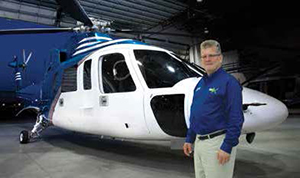
Taking a Step Back

It can be easy to get caught up in the moment. We all go about our work every day and do the things necessary to do our job. Sometimes, it’s just a series of steps that are required to get through the day, and as we get busier, we can find ourselves easily overwhelmed – working long hours and often just putting out a series of fires.
As we gain experience, we take on more work. Eventually, the need to keep up with added responsibility can bury us. If we are a conscientious mechanic, we won’t take on so much that our work suffers – but the inevitable result is that the quality of our work can suffer.
This is why it’s important to regularly step back from our day-to-day duties to evaluate where we are and put steps in place that can ensure quality and safety. This may mean reorganizing our tools, seeking out training, or even asking for badly needed help.
It’s important that when we do step back we start by reminding ourselves of responsibilities as a mechanic (safety, honesty, etc.), and be sure that we are doing everything we can to meet the objectives by which we started our job.
As owners of both Helicopter Maintenanceand D.O.M. magazines, we are faced with some of the same challenges. We have been growing at a regular pace since we launched Helicopter Maintenancein 2011, and it’s easy to get mired in all the duties and responsibilities it takes to run a publishing company. I often take the time to step back and look at where we are going and how we got there.
For those of you that don’t know why we started Helicopter Maintenance, let me explain. My business partners and I launched D.O.M. magazine more than 8 years ago, and as we were attending helicopter shows, it became apparent to us that there were no maintenance publications that were written for helicopter maintenance professionals. There were plenty of helicopter magazines, for sure, but they all covered operations and pilot issues and had little coverage of helicopter maintenance. This seemed quite odd to us as mechanics, particularly since helicopter operators, manufactures and pilots rely heavily on maintenance professionals to keep their helicopters airworthy.
And as we started asking around, we learned that helicopter mechanics are kind of a unique breed of individuals. They have a different set of maintenance issues and tend to be focused solely on rotorcraft. An entire different set of equipment, tooling, and expertise separates helicopter maintenance professionals from their fixed-wing peers.
Sure, there are similarities, sheet metal skills, riveting skills, safety wire techniques and such, but we felt the differences warranted a publication that dealt with the issues exclusively faced by helicopter mechanics.
To date, Helicopter Maintenanceis the ONLY publication that is dedicated 100 percent to helicopter maintenance. In the last year alone, we have grown from a circulation of 5,000 to around 8,000 – and we’re not stopping there!
In addition to stepping back to evaluate our day-to-day activities, we’ve also taken a look at the editorial package we provide to you, the mechanic. You will notice this month that there is bit of a “change” (see improvement) in our editorial. We have decided from this point on to provide you with a magazine that is a must read. When possible, editorial will be balanced and provide information from multiple sources. Editorial will be as technical as possible and relevant to your job.
We invite you to let us know how we are doing or if you have any ideas for stories or for improving our editorial. We also would like to remind you to let our advertisers know you like our publication. The magazine continues to be provided free of charge to you because of our advertisers.
We are here to serve you – the helicopter maintenance professional.
As always, thank you for reading.
 Greg Napert
Greg Napert
Publisher, Helicopter Maintenance magazine
